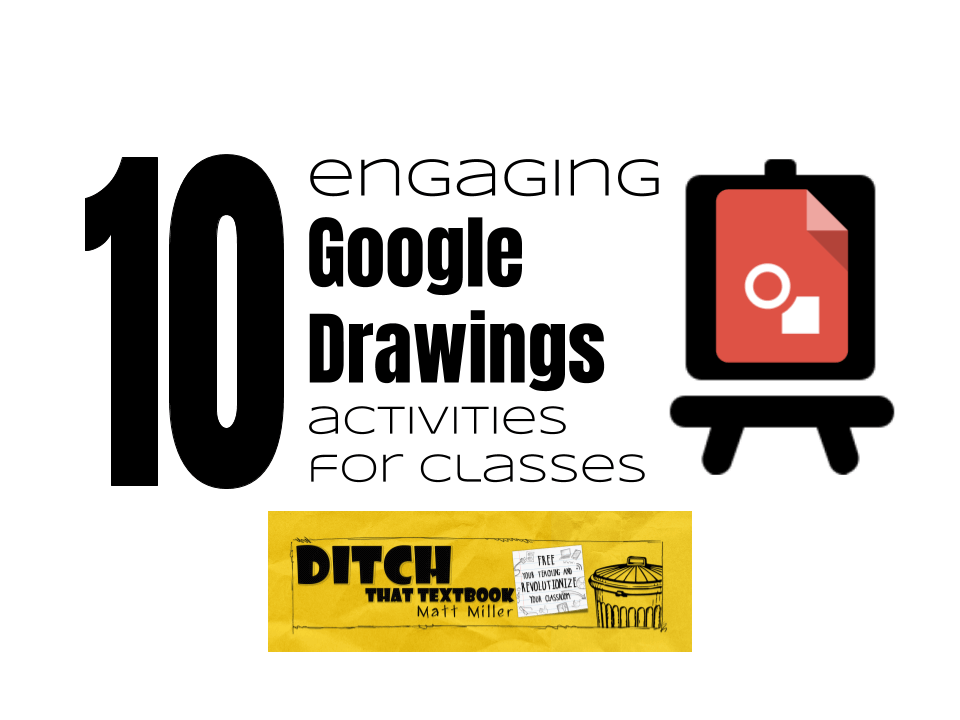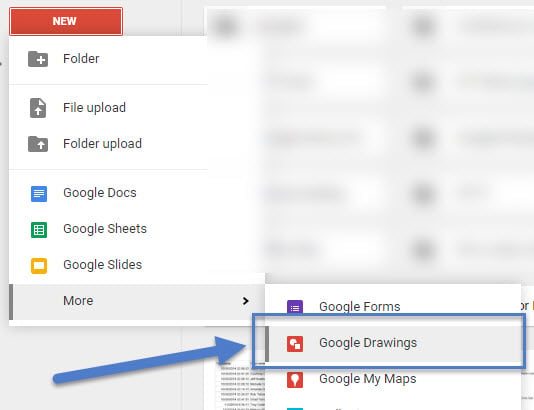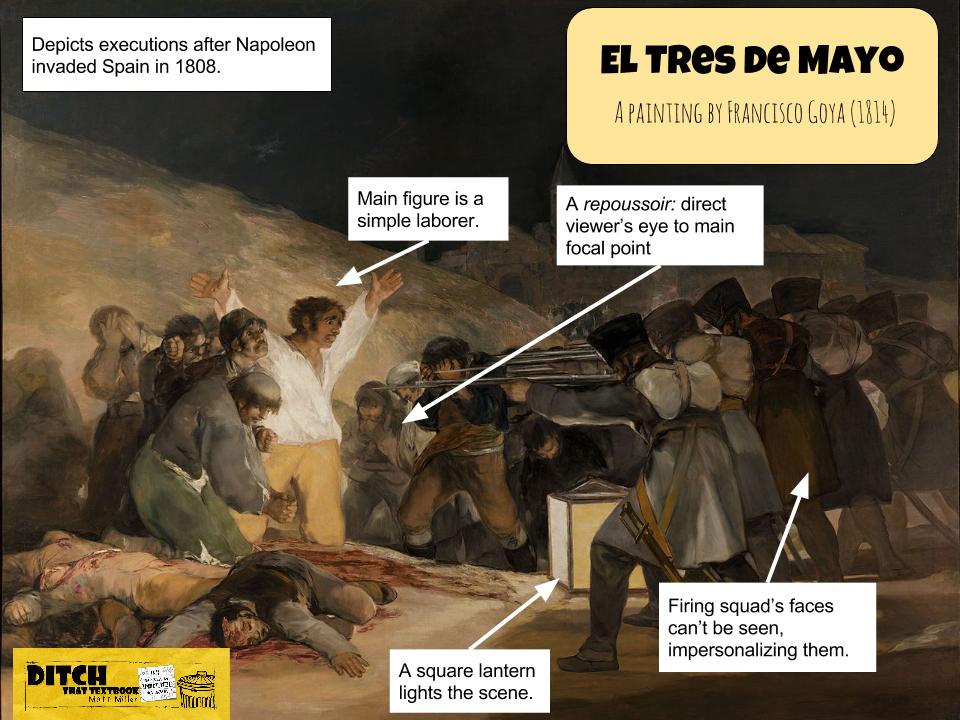
Sometimes, a linear document just won't do. Students need room to move things around and get messy. Here are 10 Google Drawings activities to do that.
Using a document in Google Apps or Microsoft Word is perfect for many activities, but sometimes they can be so limiting.
They’re restricting. They force you to enter information in a fairly linear fashion, and linear just doesn’t cut it sometimes.
Sometimes, you want your work to be all over the place. Think of sticky notes on a wall or spreading work out on a table or the floor to see everything.
When that’s what you need, your Google Apps tool of choice might be Google Drawings. Drawings is one of my favorites of all of Google’s tools. It’s simple to use but powerful and very versatile.
In fact, here’s how simple it is. The button panel for creating things (see image above) is made up of lines, shapes, text boxes, images and comments. (The arrow is for selecting items on the page.)
Google Drawings is like a digital poster board. Or sheet of paper. Or a blank slate waiting for your great ideas.
 Sadly, many educators don’t know about it or know what it does. Maybe part of the reason: when you click “new” in your Google Drive, Drawings is under the “more” tab. (What a shame … one of my favorite Google tools treated like a second-class citizen.)
Sadly, many educators don’t know about it or know what it does. Maybe part of the reason: when you click “new” in your Google Drive, Drawings is under the “more” tab. (What a shame … one of my favorite Google tools treated like a second-class citizen.)
As versatile and powerful as it is, there are bound to be lots of uses for it. Here are my top 10, and if you use Google Drawings in your classroom or educational setting, please share how in a comment below!
1. Graphic organizers — Often, students have great ideas in their minds. They just struggle to organize them into the logical sequence they need to present them. Graphic organizers can help them pull those ideas and information into a great project or presentation.
How to do it: Create a graphic organizer (think KWL, fishbone, Venn diagram … or make up your own!) in Google Drawings. Then share it with students as “Everyone with the link can view” and have students go to File > Make a copy … to create their own copy of it in their Google Drives. If you’re using Google Classroom, when you create an assignment, use the drop-down menu in the bottom right to make a copy for every student in Google Classroom.
Need some help getting started? Check out my post with 15 free Google Drawings graphic organizers and how to make your own. It’s one of my most popular posts ever! Use my graphic organizers verbatim or use them as a starting point for your own.
2. Interactive posters — Creating posters is an activity that’s a staple in many classrooms. If you don’t want to hassle with glue sticks, markers and magazines for cutting images out, Google Drawings can help. Drawings is a great spot for creating interactive posters. Regular posters are static and only contain the information you can fit on them. Interactive posters have clickable links, making the poster just a starting point for more information.
How to do it: Students create a Google Drawing. They add text boxes with information and shapes to help organize (think of the construction paper behind the text). They can add Creative Commons images by going to Insert > Image … > Search tab to be good digital citizens. (This falls right in line with my post on how to find and use images the right way in class!) They can highlight text and push Ctrl+K or go to Insert > Link … to make clickable links in their text.
Want some more guidance? Check out my post on interactive Google Drawings posters with an example you can click on and copy into your Drive if you’d like.
3. Photo comic strips — I found this one by chance at a Google conference once and really like it. Comic strips are easy to create in Google Drawings. When you add a shape to a drawing, one category of shapes is called “callouts.” Those callouts have speech bubbles and thought bubbles to add to a drawing. Upload a picture — or take a picture by going to Insert > Image … > Take a snapshot to use the camera in your laptop, tablet or other device. Then use the speech/thought bubbles to show what the characters are saying or doing.
I found this idea from Mike Petty, a Google for Education Certified Trainer in Michigan. His site about photo comic strips shows more examples and ways to use them in the classroom.
4. Interactive white board — When shared with a few students or an entire class, a blank Google Drawing can turn into an interactive white board that everyone can control. SMART Boards and Promethean Boards let the person touching the screen make changes … but Google Drawings interactive white boards let anyone make changes.
How to do it: Create a drawing. Click the blue “Share” button and click “Get a shareable link”. Then choose “Anyone with the link can edit.” OR, if you’re using Google Classroom, create an announcement and add the drawing to the announcement. Make sure the drop-down menu on the right says that students can edit.
Of course, having the expectations talk with students beforehand is useful when anyone can make changes to this drawing. My expectations talk usually includes:
- Remember that this is better than boring activities using paper.
- If we can’t handle this, we’ll be headed back to the boring activities.
- Don’t make changes to the drawing until you’re asked.
- Remember that everything you do is tracked on revision history (File > See revision history), so I’ll know who has done what.
- Anything you put on the drawing will be treated as if it was said out loud in class and will be handled accordingly.
5. Digital manipulatives — Ever have students put sticky notes out on their desks and move them around? What about cut-out pieces of paper with words or pictures or ideas? If so, Google Drawings lets you create digital manipulatives like those that you can move around.
How to do it: Create a Google Drawing. Then, create the manipulatives you want students to use with text boxes, shapes or images. Make sure your original copy of the manipulatives is “Anyone with the link can view” under the blue “Share” button. Then distribute it to students and let them copy it to their Google Drives by going to File > Make a copy … . If you use Google Classroom, add it to an assignment (graded) or announcement (ungraded) and choose to make a copy for each student.
Some examples: one of my graphic organizers from above called “hexagonal thinking” and Shake Up Learning’s collaborative magnetic poetry.
6. Annotate images — Thousands and thousands of images are available in Google Drawings (as well as other Google Apps). Just click Insert > Image … and choose “Search”. You can always upload your own images. Once they’re in a drawing, use text boxes, shapes and arrows to write over the top of those images. Use them to tag important features, add commentary, circle or highlight key concepts and more.
7. Informational graphics — In traditional research reports, students gather information, analyze and organize, and then present their findings in essay style. They could demonstrate all of those findings in another way — with an informational graphic! Infographics are all over social media and are very popular. Learning to create an infographic is a useable skill in the real world.
How to do it: Create a new drawing. Do some internet searches to check out some infographic examples. Plan how to organize the infographic and how to illustrate research findings. Create using lines, shapes, text boxes and images. Add clickable links to text and images.
8. Timelines — Use the same elements from the informational graphics above to create timelines. Add a horizontal line to a drawing. (Pro tip: Hold in shift while drawing the line to make it truly horizontal and straight!) Add information for the different dates on the timeline and illustrate them with images.
9. Add and pass activity — Get the whole class working together in this activity. Each student creates a drawing and starts an activity — an illustration, a comic strip, a story … something. Let students work on it for a couple minutes. Then have them rotate to a different desk and work on someone else’s activity. After a few minutes rotate, then rotate again and rotate again. Eventually, the activities get completed. It’s fun to see what the rest of the class did with what you started off with!
10. Tutorial graphics — Teach someone how to do something with a tutorial drawing. This works great with tutorials for doing something online or on your computer/device. Add images to a drawing of what you want the reader to do. These images can be created by taking a screenshot. You could also find images in an image search (Insert > Image > Search) or create images with lines and shapes. Describe what action to take using text. Then share those images on a website, with a link or by adding them to a document.
[reminder]How have you used Google Drawings? Which of these ideas are you likely to use?[/reminder]
For notifications of new Ditch That Textbook content and helpful links:
- like Ditch That Textbook on Facebook
- follow @jmattmiller on Twitter
- check out the #DitchBook community on Twitter
- follow Ditch That Textbook on Pinterest
- subscribe to the Ditch That Textbook YouTube channel!
Interested in having Matt present at your event or school? Contact him by e-mail!
Is Matt presenting near you soon? Check out his upcoming live events!



I’m interested in learning a lot about art and tech skills to develop my talents.
That’s nice.
These look very useful, and I’m particularly interested in using #3 and #6. I’ve recently begun teaching 8th grade world history and geography. The most successful outcomes in geography I’ve ever had in the classroom came from using Google Drawing to create maps and then have students practice and memorize locations. I copy a blank map that corresponds to either a map in our world history atlas or one online, which I will project on the board. Then I have students work on specific types of geographical labels (regions, capitals, rivers, etc), inserting text, and then sorting out the types of labels by color and shape (water = dark blue, capitals are stars, etc).
Combining this with practice using Quizlet, I’ve had students find much more success, and the level of engagement is quite high at first because of the novelty. Students can see how they master this, unless they have a specific learning disability that affects their ability to do this particular activity.
It’s easy to evaluate the results — you copy one of the maps the more able students have done, and move all the labels to the side, eliminating some, and have students use it as a quiz. I plan to elaborate this activity by having students create itineraries using Google Drawing and maps, with callouts describing what they’ll sight-see that’s of historical interest.
I’ve also used Google Drawing for concept maps and timelines. Interestingly, students were very engaged by making outlines in Google Docs, which I thought would be deathly dull! But then they were new to Chromebooks and the apps…
I have never used this technique. But it looks like fun.
I will definitely use graphic organizer for Science Notes and Info Graphics for Social Studies.
[…] HERE for 10 ways to use Google Drawings […]
This format would be an excellent way to have the students in my Science Lab demonstrate investigations. With the proper permissions, their demonstrations could be posted on my web page for all the grade levels to visit.
My Music classes can create a Comic Strip to a Song/Music!
Using the timeline for famous american TEKS would be an engaging and hands on activity that I would definitely utilize.
I am interested in using the graphic organizers in my classroom.
I could see using annotate images as part of our Non-Fiction Text Features lessons. I think our second graders would retain so much more information through this interactive lesson.
[…] Ditch That Textbook– Matt Miller has compiled 10 Engaging Google Drawing Activities For Classes including interactive posters and comic strips […]
[…] Sourced through Scoop.it from: ditchthattextbook.com […]
Matt, I have recorded two webinars on creative uses of Google Drawings. You can view them at the links below:
Google Drawings for Graphic Organizers – http://ti.apps.sparcc.org/videopd/20141204-graphicorgs
Teaching Math with Google Drawings – http://ti.apps.sparcc.org/videopd/20151105-math-drawings
Hi Matt- One of the English teachers in a school in my district is having his speech students use Google Drawings to organize their notes and resources for an upcoming speech. He created a template, added a color-coding key, and pushed a copy to each student through Hapara workspace. (This could easily be done through Google Classroom as well.) This is the first time any of the students have ever worked in Drawing and the feedback so far has been very positive. Drawings gives them the freedom to move their ideas around the canvas until it is just right. Thank you for sharing so many more ideas for how to use this awesome tool!
Beth, when I saw your name on this comment, I knew there would be something great! What a cool idea to organize info for a speech. I love it!
[…] 10 engaging Google Drawings activities for classes | Ditch That Textbook […]
I never really explored Google Drawings until I read your post. It’s super simple and full of possibilities. I’m definitely going to include it in the next Google lesson I do. Thanks!
It’s a very simple but versatile tool … one of my favorites. Glad to hear it!
[…] Sourced through Scoop.it from: ditchthattextbook.com […]
Hi Matt,
I met you a couple of years ago at Digipalooza here in Scottsburg. (Learned a lot – thanks!)
I love your blog and I love what you do. I have a couple of questions for you please…
I love to have illustrated notes day where my class and I draw scenes using vocab and verbs to form sentences. What app do you use to draw your stick-figures? How do you re-incorporate them into your Google Drawing poster page? I tried to free-hand doodling using the trackpad of my MacBook, but the result was embarrassing, even for me (and I have no pride when it comes to doodle). Do you draw on another app (using an iPad?) and insert the image back to Google?
Thanks so much for what you do – you give me a lot to consider and try to implement.
Hi Lana — The app I use to draw is Paper by FiftyThree on the iPad. I save the drawings to my camera roll and then transfer them over to my computer (usually by emailing them to myself). Hope that makes sense … if not, comment again or email me and I’ll be happy to walk you through it!
Thank you for these ideas. I loved learning about Google Drawings at your conference in Plymouth, IN, but I’ve had a hard time implementing this tool in my classroom. This gives me some concrete ways to use it with my students.
[…] 10 engaging Google Drawings activities for classes #gafechat @jmattmiller Great ideas! ditchthattextbook.com/2015/11/02/10-… […]